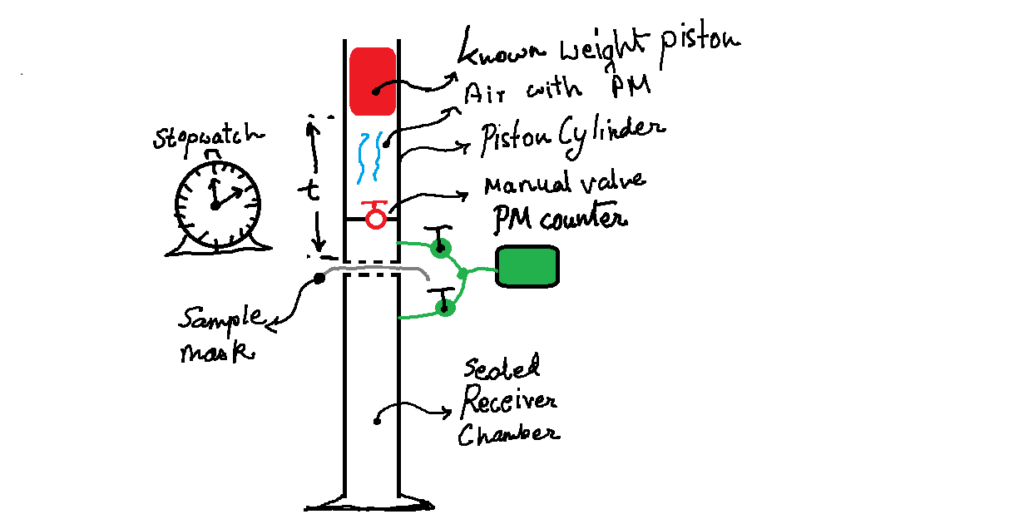

concept → prototype


A proposal for funding by engineers of the India COVID SoS volunteer network.
Updates – 21st Oct. 21.
Approved for funding by Give Back Foundation, USA. Awaiting process.
Host organizations – Anubhav Prathisthan, Karjat, MH, India & Vigyan Ashram, Pune, MH, India.
The last year has seen a proliferation of manufacturing, innovation, import and small scale production of various kinds of masks, from medical grade surgical, disposable FFP2 and equivalent to reusable versions using a variety of materials and manufacturing methods. A recently released report from a large scale study carried out in Bangladesh clearly shows that masks are effective in reducing COVID spread but that the reduction is also based on the types and materials of the masks themselves. In the absence of broad regulatory standards, it is difficult for healthcare providers, relief organizations, NGOs and the public in general to know if the masks they are using meet the minimum requirements for infection prevention. Given the effectiveness of universal masking in reducing transmission rates for a variety of pathogens, we feel access to mask testing is a critical need, especially in the global south where this infrastructure remains lacking. In India, there seems to be no publicly accessible mask testing service. Similar needs can be seen in many other developing countries. Often masks have to be sent to the US or the EU to get tested.
In Phase 1, we propose to make an opensource and open-hardware face mask quality testing device.
In Phase 2, we want to develop a testing protocol and try it out with 3-4 NGOs in India or elsewhere.
Currently, we are seeking funds for Phase 1 only.
Around the world, there are a variety of professional lab-based setups and amateur setups to test masks for the public (see a non-exhaustive comparison table here). However, these are often geographically far from the global south and operate with varying levels of sophisticated equipment needing trained people to operate and interpret. Often amateur setups provide only qualitative testing. In short, either they are relatively inaccessible or inadequate for local testing needs. Currently local testing does not take place in much of the global south.
We want to make a portable, compact, high shelf-life, easy and minimal interface mask testing device with testing for 3 key parameters of particulate filtration efficiency (<PM0.5), breathability (pressure drop) and fit (qualitative). It is intended to be used by minimally trained technicians or amateurs on field sites in non-lab settings. The device cost is to be kept low and its design to be open sourced for replication and improvements. We want to develop an appropriate testing protocol.
It is envisioned as a made-to-order device catering to the needs of NGOs in a country (whoever can afford and staff it) along with being a template device intended to be replicable in other parts of the world by the maker community. We don’t intend to make a certified and calibrated unit as that would significantly increase the challenges, budget and time delays. Instead, this device will be operated as a citizen science unit expecting discretion by the users and consumers of the device’s outcomes.
Figure 1 : Outline of the device
The main idea is to make an instrumentation box with a human interface (screens and buttons) equipped with 2 interfaces for carrying the following types of tests. The box could be placed in a closed and sealed room for the sake of experimentation.
Each device can cost somewhere between INR 40-56k or USD 520-750, depending on the sophistication of controllers, interfaces and features. See the components list here. Taking a conservative estimate here is the overall project breakup.
| Task | Cost (USD) | |
| 1 | Cost of 3 working prototypes to be manufactured. | 2,300 |
| 2 | Development materials, test benches, consumable costs, etc | 1000 |
| 3 | Human resource costs for the remuneration of 4-5 engineers/researchers | 2500 |
| 4 | Testing of 1 prototype with standard test equipment in the US/EU | 1000 |
| 5 | Institutional overheads | 700 |
| Total | 7500 USD |
The funds will be held by a non-profit NGO – Anubhav Prathisthan Trust based in Karjat, near Mumbai, India. The host organization will be another non-profit NGO – Vigyan Ashram, based in the city of Pune. The work will be carried out and directed by Subir Bhaduri, in his workshop Pune, in collaboration with the host organizations and the team of mentors and volunteers.
# | Task | Weeks (total 3 months) | |||||||||||
| 1 | 2 | 3 | 4 | 5 | 6 | 7 | 8 | 9 | 10 | 11 | 12 | ||
| 1 | Brainstorm & freeze design V1 | X | X | ||||||||||
| 2 | Get off-the-shelf components | X | X | X | |||||||||
| 3 | Get custom made components | X | |||||||||||
| 4 | Assemble and code | X | X | X | |||||||||
| 5 | Develop testing method | X | X | X | |||||||||
| 6 | First testing | X | X | ||||||||||
| 7 | Review of design – V2 | X | X | ||||||||||
| 8 | Order and get components | X | X | ||||||||||
| 9 | Assemble V2 | X | |||||||||||
| 10 | Testing V2 | X | X | X | |||||||||
| 11 | Send V2 to field testing | X | X | ||||||||||
| 12 | Make modified design – V3 | X | X | X | |||||||||
| 13 | Order components for 3x devices | X | X | ||||||||||
| 14 | Assemble 3x devices of V3 design | X | X | ||||||||||
| 15 | Field testing of 3x devices | X | X | X | |||||||||
| 16 | Documentation and closure report | X |
Since we all are working remotely as well as locally, the overall project is divided as per tasks and owners who will be responsible for those tasks. The remuneration is discussed accordingly. See table here. The project leader is Subir Bhaduri, a freelancer with active interest in social technology development and also an active member in the India COVID SoS group.
Ideally we would need a solution like this. But with some drawbacks.
The following video gives an insight into parallelogram mechanism.
Cameras and lighting equipments often need to be positioned arbitrarily in space for optimum photographic effect. Similar need is identified for persons who are bed-ridden and need to place their laptops or communication devices in the right positions. Such a user may need to access the laptop while in either supine or lateral recumbent positions. One such need was expressed by a client of NISH, Trivandrum. The client (young male with spinal cord injury and who is bed-ridden) struggled to find the right device to hold his laptop at the right position for optimum visibility and use. This paper discusses attempts to create a generic laptop mount which offers lockable articulation needed for optimum positioning. Existing market solutions are discussed first, followed by identified engineering constraints and challenges of this project. Prototypes designed by the author are discussed next, concluded by open challenges yet to be solved in this project.
Some existing products and their constraints are discussed here (non-exhaustive)


As a conclusion, it seems a proper robust over the head or from floor to bed size adjustable arm is necessary. This essentially has to be a low cost device as compared to the imported devices listed above.

What was proposed originally was a 2 beam device, modeled on the Manfrottos’s Magic arm, but of obvious large size. In the depiction below the base is mounted on trolley wheels for portability.
The challenge was the proper design of necessary friction to lock the ball in position. Designing hinge mechanism with built in friction actuator to fix the ball joints on both opposites of the central hinge was another challenge. A ball with stem was harvested from a Toyota Innova front wheel ball joint.
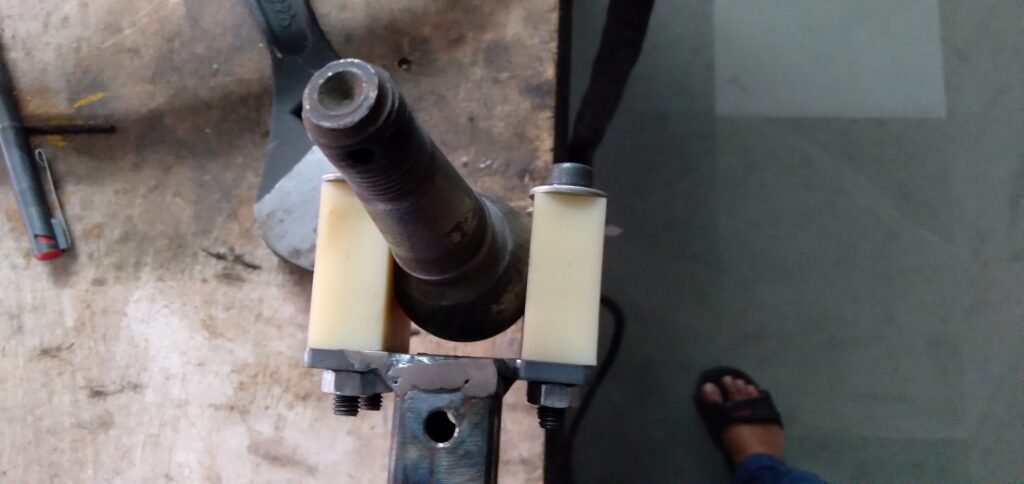
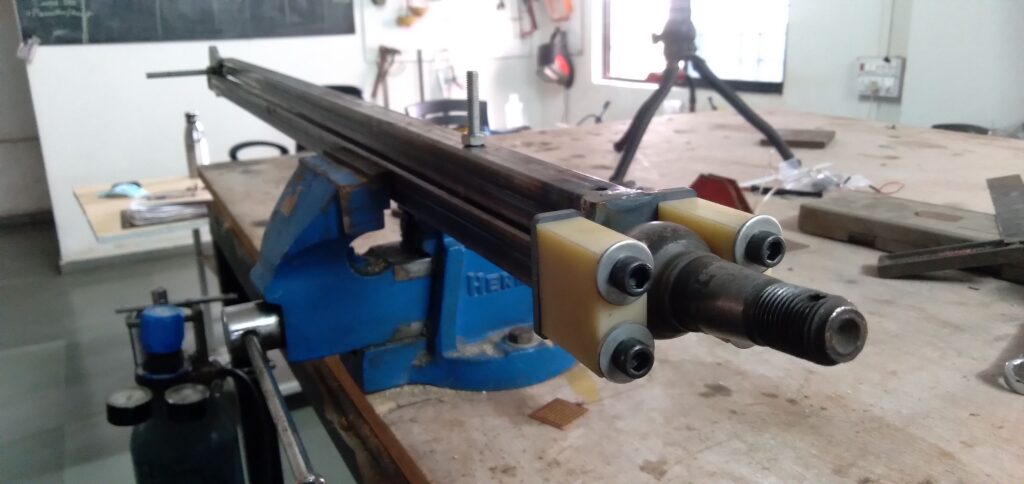
Reasons of failure : The arms flexed quite much, not enough to hold their own weight when in the air. See a video here. Much more friction or tightening grip was needed.
In prototype#2, I used the ideas of hydraulic power to increase friction grip to the ball. The same Toyota Innova ball was used and a bracket clamp to grip the ball was made by hacking the disc brake housing of the common Bajaj Pulsar motorbike. 3 ball joints were used, all connected to a single pump. Once pumped, all 3 ball joints clamped the respective balls, and thus should have fixed the positions in arbitrary space.
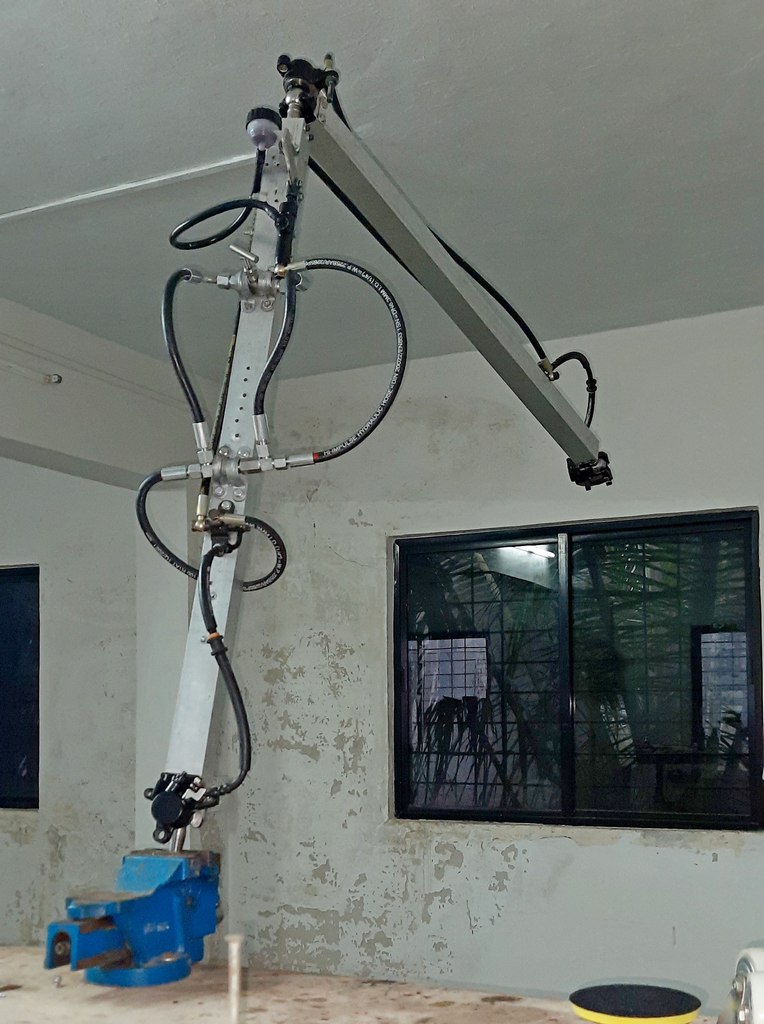
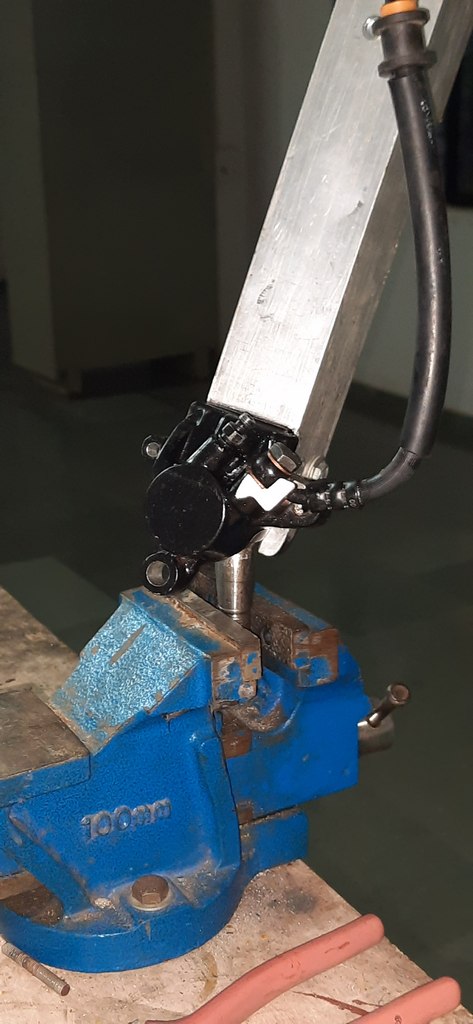
Reasons for failure: The overall structure turned out to be very heavy, the pumping of hydraulic system was cumbersome and it seemed that it worked but not not quite steady. It also seemed this oil can leak, not a very good proposition for a home system.
See the video : https://youtu.be/FFYfDo6Lw74
Another ‘pincer ball’ mechanism was attempted, but now with a bigger ball. The balls are commonly found from home decorations, railings of stair cases which are in fashion in the markets of India now. The grip was added with a rubber sheet to increase the friction.

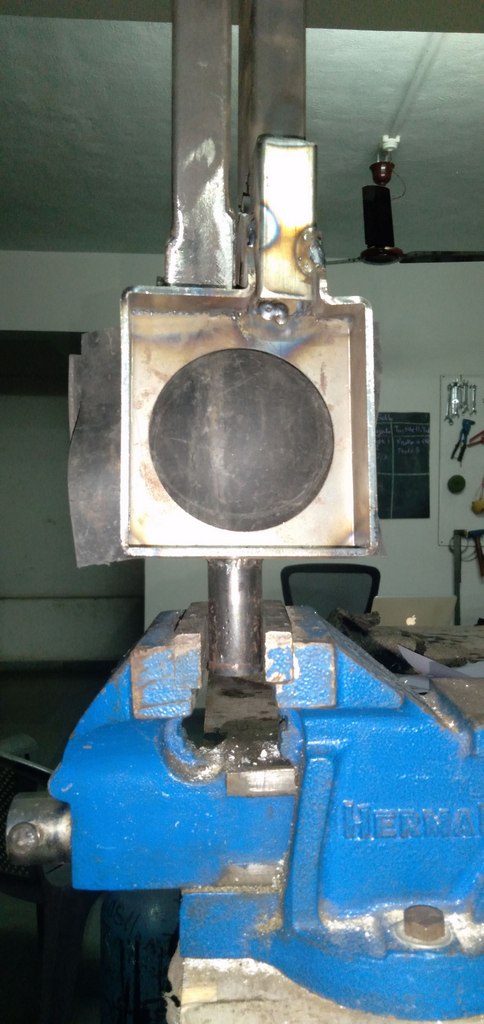
Inspired from the instrumentation articulated arm clip here, I wondered why not enlarge the system? Here’s the number of prototypes I tried. The idea is that there’s a steel cable which passes freely through each ball (there are 2 holes in the ball) and pipe. It is tightened against the length of the system, so that each ball and pipe presses against each other. The resulting friction should lock the components together, with possibility of holding itself in arbitrary shapes and positions.

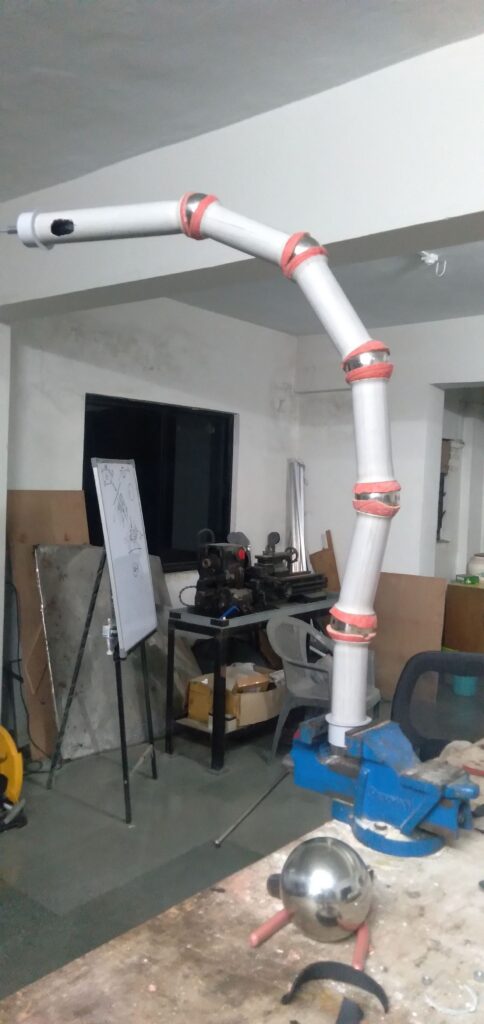
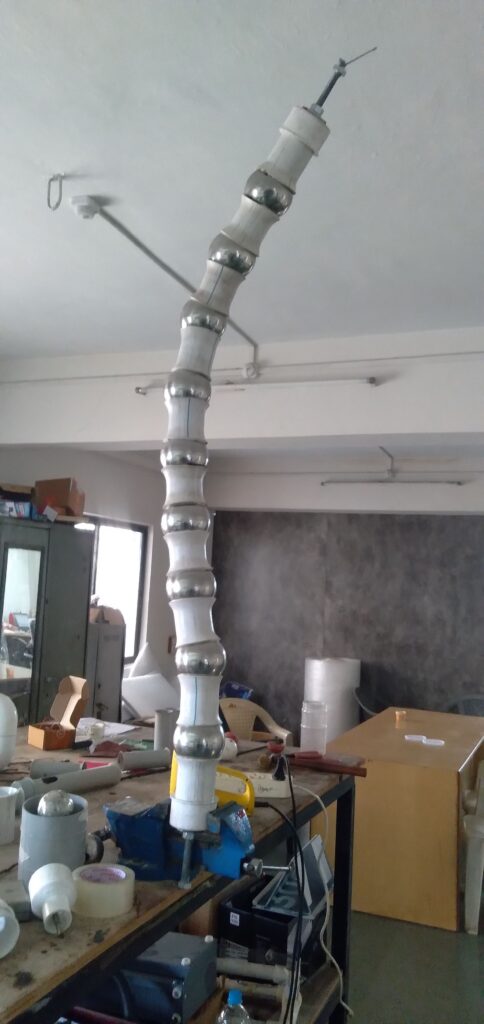
Reasons for failure: The friction created on the lowermost ball is not enough. It droops under the weight of the overall device. Some better method to increase friction between each ball and pipe is necessary. This method has promise, but only for smaller table top mounts perhaps.
It seems frictional locking will need immense amounts of friction, which will not be tenable engineering-wise. One alternative is to have teeth to teeth locking system (like gears) and articulating 1-axis joints instead of ball and socket designs tried so far. This is the conventional engineering way. Another interesting way is perhaps to do away with frictional joints altogether!
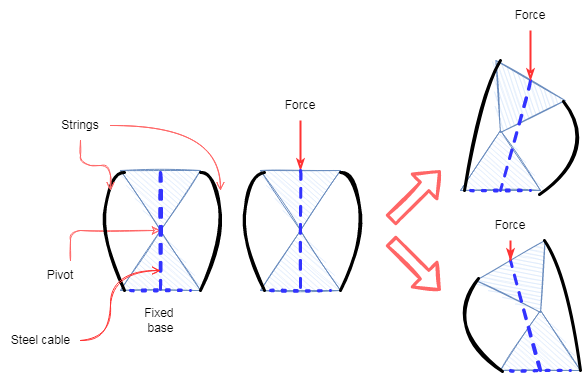
In the above figure, 2 bodies are illustrated fixed to each other at a pivot point. When there is a cross-stress across the 2 triangles with the pivot point midway between the 2 bases, the triangles may flip on either sides, as shown. There are 2 loose cables on the side, which help fix how much the triangles bend relative to each other. So, another way to put it, instead of creating structures with arbitrary angular positions in between, how about create a “bistable” joint, with only 2 possible states? Imagine a long chain of multiple such triangle pairs, all connected via a central steel cable, the tension of which can be adjusted to result in bistable positions of each element. Thus this chain can be configured in arbitrary configurations!
An example of this was somewhat successfully tested in the following prototype. Here multiple discs of a certain shape and wedged into each other, and tentioned by a steel cable. The tension can be adjusted. The images below show a state which could be achieved.
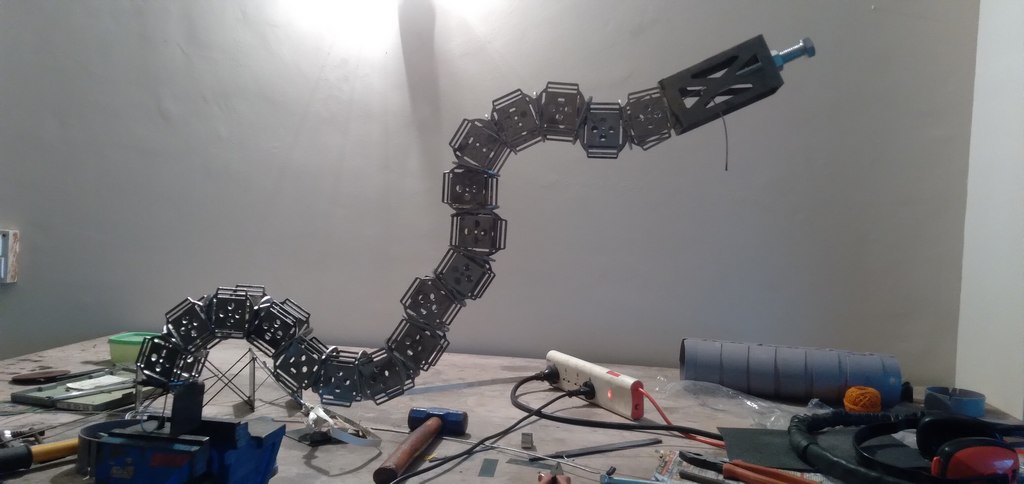

While the idea kind of worked, and seems to be the closest prototype I could achieve towards the target engineering constraints, it was a flimsy design. Many flaws came to light, one being that under slight overstress, the discs would pop off and the whole thing collapsed. Also, it was very difficult to adjust as the friction between each disc was very high, something i foresaw, but still went ahead to make.
In order to make a friction free design of easily “snappable” bistable elements, i resorted to what is called a flexure joint, or in engineering terms – cross-linked flexure pivot joints. Such a structure has bending movements only along a certain axis and is significantly rigid on all other axes.
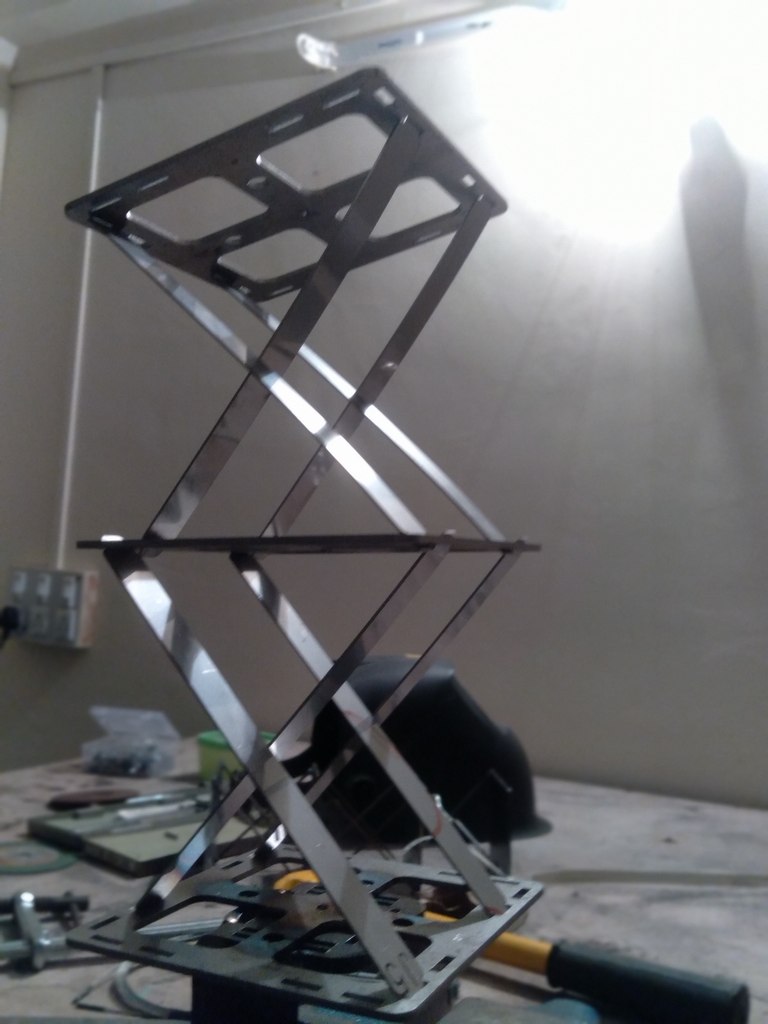
However, I realized that while the pivot position is virtually fixed, it in practice moves with the rotation, thereby resulting in the tentioned string method of adding compressive strength as non relevant here. Since I could not stress the elements in other way, this design failed.
Many prototypes have been tried, with various minor successes but major failures. However, I have come to a better understanding of the challenges involved. Hope it works in the next few attempts.
I love making tools and devices. Technologies such as cars, engines, electronics, science instruments or even, I shall admit, attack/defense technologies like guns, fighter aircrafts, ships, etc entice me. There seems to be an innocent joy on seeing and relating to how these machines work, unrelated to the political and social contexts where these are used/misused. The movements of the parts, their relationship with each other, technicalities of design, materials used, challenges to be solved within given resources, the histories and stories of evolution and uses, etc., all these make me glue in to the subject. My own journey as a maker has similar acts of learning new tools, designing within constraints, troubleshooting, struggling with materials and their properties, thinking about the end-use situations, identifying right machining methods and so on. As a maker the world is full of very interesting toys, one could happily get lost in. Except perhaps when one opens one’s senses to the real wide world.
While I love being a hardcore technical maker, I am also a sensitive human being, with feelings and emotions, living and absorbing signals from a complicated and dynamic society around myself. Environmental crisis, class divide, hate, unfair distribution of resources and power, insult and oppression of the unfortunate by the fortunate, the examples just go on and on. I can’t stop noticing them, not being affected by them, not asking myself how am I, with my relatively immense privileges, adding to the tragedy. It makes me deeply divided in conflict. And to discover that so much of technology is directly involved in increasing the unfairness in the society and cause environmental destruction, is a real tragedy. For many years I have had this struggle, and it still continues. I am only beginning to ask deeper and better questions to myself. I have changed my profession a few times in an attempt to find a place where I could practice my love of making while also behaving as a conscientious designer. And I know that many fellow technologists do not have this privilege, or worse, do not wish to acknowledge and practice this privilege.
My main conflicts with modern industrial technology lies in the following observations:
But since all of these are lofty concerns, I would rather like to focus on the makers of technology, my tribe and my territory.
Technology is often portrayed as being unbiased and neutral. It is argued that technology is designed while not worrying about who uses it, how and to what end. An aloofness of the maker is imbibed as the dominant technological culture of our times. A similar argument is used by the proponents of personal guns in the US or the proponents of nuclear weapons or even the people working in a nation’s defense industry. The arguments put forward by corporations sell a similar story. They say we make technology to serve the interests of a market and if we don’t do so, how will we survive? They say the market buyers will have the moral duty of when, where and how to use the technology while the makers of technology need not be burdened with such lofty philosophical and political questions. In short, makers of the most powerful augmentation of the human experience conveniently insulate themselves of the consequences of what they make.
Many proponents of the “tech is neutral” school of thought may agree that the world of technology is costly, hence we need to make the economy better (trickle down school of thought), so that more market opens up and technology becomes accessible. When it comes to environmental crisis, the argument is that technology by itself didn’t cause it. It allowed for the greed of the human being to be expressed instead, which turned out the way it is now. If the environmental crisis has to be controlled, the people who use technology should learn better, take it on themselves to not pollute or abuse the ‘gifts’ of technology. One may also argue that tech is the only way we will get A) a good quality of life for all B) solution to the environmental crisis and C) all novelty that the future has a potential to hold. In all cases, the maker of the technology, the producer of it are conveniently let off on the responsibility of technology.
Makers of technology, like me, the ones who are nerdy enough to pick up engineering/science as a career, essentially work in a super-hierarchy, far removed from the end-user as well as the context of use of their technology. A big chain of administration, sales, marketing personnel, bankers, market researchers, market forces block the direct view between the maker and the user. This distance automatically makes it impossible to control how the tech will be used, thus implying a kind of systemic neutrality by default. The distance also has the consequence that the maker no longer can design with a relevant enough understanding of the end-user/context, thereby making it mandatory that the end-user/context has to adapt instead to the technology. Such an arrangement implies that most technologies are meant for a niche section of the population which meets an arbitrary but absolutely necessary criteria for access. Criteria could be listed as those having adequate economic surplus, education and training to use such technologies, capacity to adapt one’s ability towards a remotely designed often miss-fitting technology and an unmet need which the said technology promises to satisfy. These criteria are stringent and non-negotiable, and therefore by design, technology only reaches a small proportion of the population.
An example could be found in the domain of assistive technology where one person’s adaptability to technology is quite limited, in contrast to the mainstream neuro-typical and body-typical population. The scope of adaptability also varies between individuals, or even as the individual grows older. Such a diversity is therefore never catered to by the mass production philosophy of the industrial model, which solely functions on the assumption that any individual, however unique, will and can morph into a standard “average” stereotypical consumer. Those who need customization, well they either should have a lot of money, like the defense industry or just struggle with a low quality of life, example being the people with disabilities.
To my naive eyes, I see more than 90% of a population, be it in India or in the world, not having access to technology. Technology seems to be the reserve of the top few percents of the population, although the statistics and sophistication of technology certainly has many variations within this range.
My thoughts expressed here originate from a certain despair. I see most people who do not have the money to buy technology not have access to technology. I see technology producers only be concerned with the small niche of the human population. I see technology as the prime driver of bringing conveniences to people (who can afford it). These conveniences only increase the distance between the users and their environment. In ecology we study that the most sustainable species is one where there are multiple other spices which co-exist and balance each other. If the number of a species grows, then ecosystem balances itself by increase in predation. If a predator or food species is removed from the system, dependent species may either increase into too many and upset the balance or may just die off due to lack of food, respectively. In a similar way I think the human species needs the ecological counterparts to balance itself. But conveniences brought in by technology are the key reason for our unbalanced and unchecked existence. Each technology essentially takes us away from being vulnerable to the ecosystem in a good and healthy way. Our state of the world is nothing but a demonstration of what disconnection looks like in reality. Technology makes us the evil gods, we destroy each other, and we destroy the ecosystem.
Who makes technology? People like me, makers who are good in the making of machines, who are perpetually fascinated by them. Who pays us? As you may know, the making of technology, its design, its various prototyping stages is an intensely resource intensive process. It takes a lot of time, lot of materials, a lot of testing, and a lot of failures to make a new technological change which may or may not lead to an ‘innovation’. No wonder it is amazingly costly to do hardware engineering. Having produced and failed multiple times in many such projects, I now can vouch for what I say – that its not easy to make hardware. But we makers are not in this game to find ease, is it? We love the technical challenges and get kicks out of them. And to keep this bunch of hardware nerds (like myself) going as well as the flow of materials and prototypes, there have to be significant economic resources to fund such experiments. Who pays for innovation in the hardware world? The government to some extent and mostly the private companies who see some future profits. Common people can’t fund hardware R&D, in the way it is known. All the people involved in these powerful places, have higher ups who they wish to impress, so that they can “survive” and grow. These higher ups have more higher ups, and the chain continues. By the time this impression chain reaches the top of the mountain, its far from the people it wants to serve. The sea of the willing, imagined people, is all they can look from the top, people those who can easily be clubbed as an average consumer. In terms of the government, this chain ends into political leaderships who are always deeply concerned about their own ‘survival’ in terms of votes and popularity. Both the bulk mass market and mass votes visionaries are similar in 1 aspect. They consider a small but powerful and noisy faction of the population as the whole “world”, it becomes their ‘bubble’. They also think in averages, and in large numbers. “Scale-up” is the business buzz word! As one operates away and distant from the people for whom one designs, the language used changes. Needs of the people, expressed in a nuanced and subtle language get trumped by popular buzz words which could be sold to the niche world. This niche crowd are also those people who were born into privileged societies, having access to parental exposure to technology and fashion trends. They are also less affected by local factors such geographic locations, local cultures, local climate and environments. In effect they are a completely disconnected, a different sub-species of the human population, only remotely related to the people expressing grave unmet needs. Yet, it is exactly these elite classes who have the capacity to pay and popularize a tech, irrespective of who needs it. The neglect of small communities with diverse sub-cultures, diverse languages, diverse needs, lack of economic resources thus becomes profound. The subsection of the human population with most critical needs (therefore implying non-adaptability) who are obviously without money and without politically relevant and consistent voice are no more the target audience of tech makers and promoters. Diversity is bad for either the politicians or the corporations, thus the need to standardize the population. Our educational system is a prime example of the “averaging” process to produce close to stereotypical consumers and voters.
My realizations may not hold true for other keen observers of the society, yet this is my experience. In my own work I try to navigate through this jigsaw of moral dilemmas and the joys and turbulence of making technology. My current idea of ‘good’ tech is one where the developer is in close proximity to the end-user, where the development and consumption of tech co-exist within an environmentally vulnerable ecosystem. I stress vulnerability here! This essentially implies smallness. The opensource movements, the citizen science movements, ideas and thoughts of various scientists, engineers, teachers and fellow makers help me articulate this, help me dance in hope of finding this dynamic sweet spot within the tech spectrum. Being a small developer allows me to have small overheads, and thus a small development fee structure affordable to the common people or NGOs. It also forces me to not be disconnected from the local circumstances, local cultures, local dreams of my end-users. As a cautionary note, what I am expressing here is still a dream in progress and I flicker about this central theme. My comfort/conveniences are pricey as compared to the people I wish to serve (being so privileged and all), and so is my social status. Both are in a state of hand-to-mouth existence often, which is a struggle at times. But I feel immensely lucky to have come across some teachers and practitioners, who are themselves in search of the sweet-spot. And no, these few folks are definitely not to be found in the elite (read elite-loving) tech organizations of the country like the IITs or the various government labs and tech-hubs. However, its sad to be locally alone and not being able to find day-to-day collaborators in this space. I am often surprised why so many bright minds can be seen pursuing often silly, artificially generated and sterile problems of the rich (particularly the defense, space tech, IT, bio industries), while the real and interesting challenges lay open for exploration in the places where a diverse population lives.
There is an old story of relevance here. A police officer finds a man frantically searching for something under a streetlight in the middle of a dark night. Worried, he asks, “Hey! What have you lost?”. The man says, “I’v lost my keys”. Policeman “Where did you see them last?”. Man, “In the alley over there”, pointing a finger to a dark unlit building far off on the other side of the road. Baffled, the policeman asks ” Then why the hell are you searching for it here?”. The man: “Its bright in here, I can see”. One does what one finds easy, and not necessarily what is right or necessary, it seems. This is the dilemma of us technologists.
As seen in the previous posts (What is math to us? and What is a function?), math is relevant and practical, at the least. It is the means through which humans can comprehend the world in a definite manner, with more and more evolving ability to objectify and count complicated phenomena. But as a student of math, how can we act on math, like in day-to-day terms? I suppose the overall scheme is:

The list above could be represented by an illustration as a spiral path of science. Here one begins by observations and makes multiple interpretations of it. Some of these interpretations form various kinds of ‘interesting’ graphs and also include some manipulation of the observed data to form different and more revealing graphs (Visualization). These graphs are then broken and tamed with graphs of known functions and eventually a textual formula or model is formed (formulation). These sets of models are used to create simulated replicas of the real phenomenon and then compared with the reality (Simulation). The broadening path indicates the many ideas and possible interpretations one begins with. But when one tests the simulations against reality, a lot of ideas are forced to be dropped from the realm of scientific thought as as they don’t satisfy the simulation=reality test, thus narrowing the path again culminating at the observation arm of the axes. At this stage, when the simulation becomes a well proven model, it could be used to further interpret or predict newer observations, as depicted by the increasing size of the spiral.
This is a good question, an i can only wonder some answers here which obviously are very naive due to the lack of sufficient thought or experience or training in the domain of mathematics. I am thinking the role of vision in our lives. The ability to sense at a distance is crucial to the survival of so many animals, including humans. With that sense-at-a-distance ability, it also needs to be good enough to interpret fast, if the remote scene is friendly or otherwise. And how do we do that? Our vision systems (sight+brain) has learnt that some patterns are good, some are bad and so in the remote scene we search for these cues. We search for patterns which are similar to what we have known so far. Our pattern seeking behavior is crucial to everything. Not all pattern knowledge is first hand. That is probably where culture, education, traditions, etc come in. But let’s not digress.
So our pattern seeking vision is kind of super trained to remove the clutter and get to sections of the scene which resemble what we have known previously through either extension/exaggeration (points depicting a line) or creative manipulation (Zodiac signs of astronomical bodies?). However, not all information is visual in nature, for example the changes in temperature over time. In fact much of the information is not instantaneous – the domain where vision works (Einstein would disagree a bit here, arguing that nothing is instantaneous. But lets escape that trap for now through a classical way.). So what graphical representation does is probably transform the significant amount of non-instantaneous information, spread over tables and tables of measured data into an instantaneous form (2D image), so that our well developed ability to figure out visual patterns within a noisy scene can come in handy.
So shouldn’t we stop here?
So although graphs made out of tabulated data do reveal a lot, often we are in need to transform the data to obtain more revealing graphs. Example could be a real data showing if x occurs with some magnitude, event y also occurs with some magnitude.
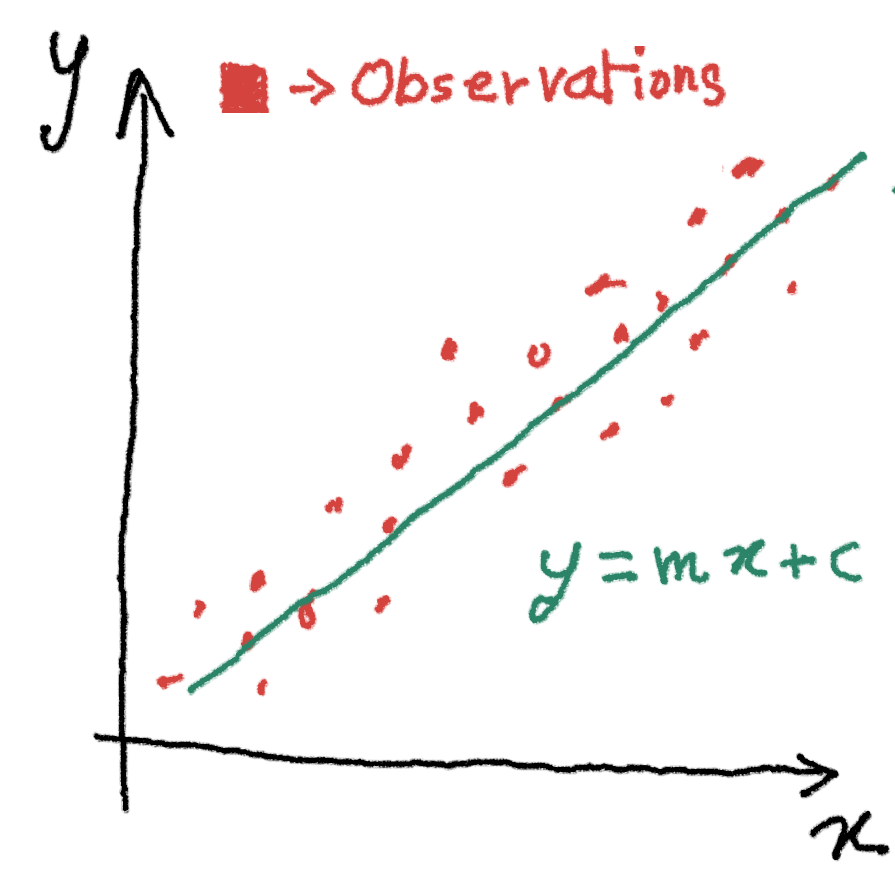
However, the observations always have some noise in them, like in the image above. Yet, knowing that Y is growing when X is growing, the observed data could be further simplified, by just doing compromises on the accuracy of the model and representing the reality instead by a simple equation.
Another good example of why an equation is helpful more than a graph is when using measurement instruments. A common way to measure temperature is through a RTD (Resistance Temperature Detector) the electrical resistance of which varies as temperature changes. This changing resistance can be measured through an electronic circuit and the temperature can be interpreted. But how? Often the RTD resistance to temperature curve is one measured through real experiments, where the resistance is recorded (y-axis) for an increasing temperature (x-axis). This curve is not a straight line. When using this device in real circumstances, 2 approaches can be used. The real experimental values (the table of resistance Vs temperature) for each degree change in temperature could be stored in a computer and any real resistance measurement can be checked against these values to get an accurate temperature. However this method will need a lot of digital data storage space and many operations. Another method is to convert the graph into a polynomial equation which has only one input and one output, the resistance measured and the temperature, respectively. Storing this simple equation and evaluating it in a small space constrained computer is much easier and safer. Although the polynomial does not exactly match the real measured curve, it remains suitable for most practical purposes. (More on this here).
The first tools to learn is tabulation and tabular operations. What better thing invented for this purpose than the spreadsheet! The advantage of the spreadsheet is that it could be used to store tabulated data, manipulate it by transformations, graph it, and and even simulate formulae into graphs.
A good base to learn spreadsheets could this.
And a good tutorial for graphing and analyzing data here.
Seriously, what are functions? We have been forced to learn what functions by definition are in our previous math courses all through school life. Bu i never understood of used those definitions in real life situations? Or not that simply as shown in the text books. So, what do we mean by funcitons?
In our daily parlance, we do use this word function as if the action associated with a tool, for example. Lets say a hammer, what is its function? Due to its design and heavy strong metal weight and the end of a long rod, when it is set into moving and obstructed by a rigid block of wood, the poor nail which comes in the way is subjected to immense forces as it is the only thing resisting the motion of the heavy metal weight brought to a sudden progressing stop! Thus, what is the function of a hammer? A tool to transfer significant amount of mechanical energy, in one direction, at a point B, lets say. But the more human question is, why bother writing it this way or that? A hammer works, why scratch our brains when we have already achieved a good tool? Probably because, if you have been given an industrial situation where you need to hammer 1000s of nails on a wooden box production line, and achieve good finish, without using much energy, its in these cases you need to understand the physics of a simple hammer so that an optimized hammering system could be made!
Thus, as discussed in the previous post, the abstractification of real phenomenon, such as a hammer, helps us reduce the complicated reality into a table of numbers. And when that reduced data is available, one can search for a complete understanding of it, by comparing it with known and well understood phenomena, such as the concepts of force, inertia, etc – via creating a function that connects or maps the real data with complicated components to a combination of known physics.
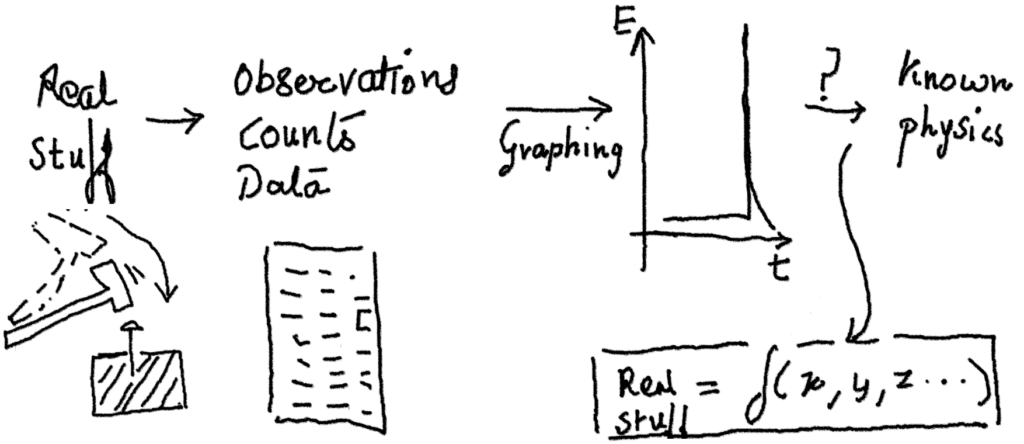
And when a real phenomenon is mapped to known physics via a newly created custom function, this custom function can then be optimized for any particular need. The same function could be used to design a machine to punch thousands of small depressions in a jeweler’s gold punching machine or be used to punch out holes in thick walls. It becomes a versatile tool! Though this process is the scientific process, the other process also exists where one learns as one goes and through intuition ‘gets’ the function embedded in experiential learning. The debate between these two processes is very interesting and has an interesting example – the contrast between Tesla and Edison. Such is the important role a function plays in our scientific method. But what does a function actually contain?
Imagine a sunflower seed. It has all the important information it needs to grow into a plant. No matter what amount of water, soil, nutrients, etc you give or not give, the seed will only and only produce the sunflower plant and not a mango tree. So a function is like a seed, it has all the information to reproduce a version of reality contained in itself, and all it requires are external supply of numbers. In other words there are 3 components to a function – input variables or doors to allow numbers to come in, relationship between inputs from various doors, and the resultant output plant or reality, written in mathematical form as :

The functional form of a plant will be contained in a seed in the form of DNA. A crop of sunflowers could be a result of many factors such as rain, temperature, humidity, pests, density between seeds, soil contents, etc. If a function of a crop of sunflower could be made, it could help in optimizing water consumption for example by accurately computing the amount of water required daily to keep crops healthy. Currently farmers do not have a mathematical function at their disposal. As we will see, it is not easy to ‘model’ real phenomena into simple cozy functions, but that is the pursuit of science.
There is a catch in the above. Can the same quality and quantity of inputs, be it the seed quality, the environment, the water, the soil, etc be the same and yet the output differ? If this were to be true, then it only means we have failed to form a good valid function. The same set of inputs must give the same set of outputs. This is the requirement of the mathematical definition of functions. However, different set of inputs can give the same set of outputs! For example, different amounts of water varied as per different atmospheric humidity could produce the same quality of sunflower crops. In fact this is the key to optimization problems we will see in future posts.
Can we explore the above chain of thoughts on other day-to-day aspects? Examples:
Why do we math? What is the role of math in our society, in our day-to-day lives? Even after using math in many ways, i don’t have a clear answer. I wonder why students would respond to these questions. It may be that there will be follwing responses:
We might know instances where and when the tiger has been spotted, but we don’t know the tiger. So the question, why do we math?
To me, the pretext lies in humanity’s difficulty in dealing with uncertainty. If you don’t know when it will rain, you can’t sow your seeds because it will then be exposed to the birds and insects which might eat them up! Or how much time we could expect the sun to be in the sky? Or, how much of material which i need can i take in return for other materials which i have surplus? Imagine the early humans who began to worry about the uncertainties like the above. How would they deal with these, day in, day out. No one has the luxury to be born to a super rich family which ensures there are no uncertainties. In fact, the super rich worry about the uncertainty of their fortune and so are back in the same loop – how to make certain what is uncertain?
One core idea, which rests the human mind to a certain extent is that of patterns. Imagine a brick house, the bricks being the unit which was repeated in multiple ways to make the house. The idea that patterns exist in our world and the universe is so relieving! The sun’s time in the sky repeats day in day out. A known amount of grains give out a known amount of crops when planted. An object thrown up falls down, and that too if its thrown up in a certain fixed way, it falls down after a fixed time! This trick is the key.
With patterns, it may have been possible to the early humans to make simple this complicated scary world. They came to know that all these complications can be reduced to replications and combinations of smaller things. For example
house = x*bricks + y*cement + x*man-hours + other bits.
Now each thing, there could be seen as something to do with patterns which are repeated and combined with other patterns to make something complicated. Had this trickery not been discovered, there would be no brick houses. We would still be searching for a nice soft rock or twigs to make our nests. The implications of knowing or not knowing that patterns exist, could be severe. Can it be said that all knowledge is that of our eternal quest for patterns? Patterns we have discovered or perceive or are yet to discover?
But does a discovery of a pattern only have an emotional benefit aspect to it? No. We do something more – we make newer patterns from it for our other needs. A reference could be made here to an earlier blog post on Stereotyping Vs Prototyping that discusses our stereotyping tendency (fit everything into limited diversity of patterns). Making newer patterns, to add to our library of patterns, could be called as prototyping. We make models with a newly discovered pattern. When Newton and others came up with simplified mathematical form of the motions and bodies of the world, others rushed to use these simple representations of patterns to predict motion of astronomical objects, or for guessing the energy required to move objects vertically across a building and so on. So these patterns become models – tools which can be used.
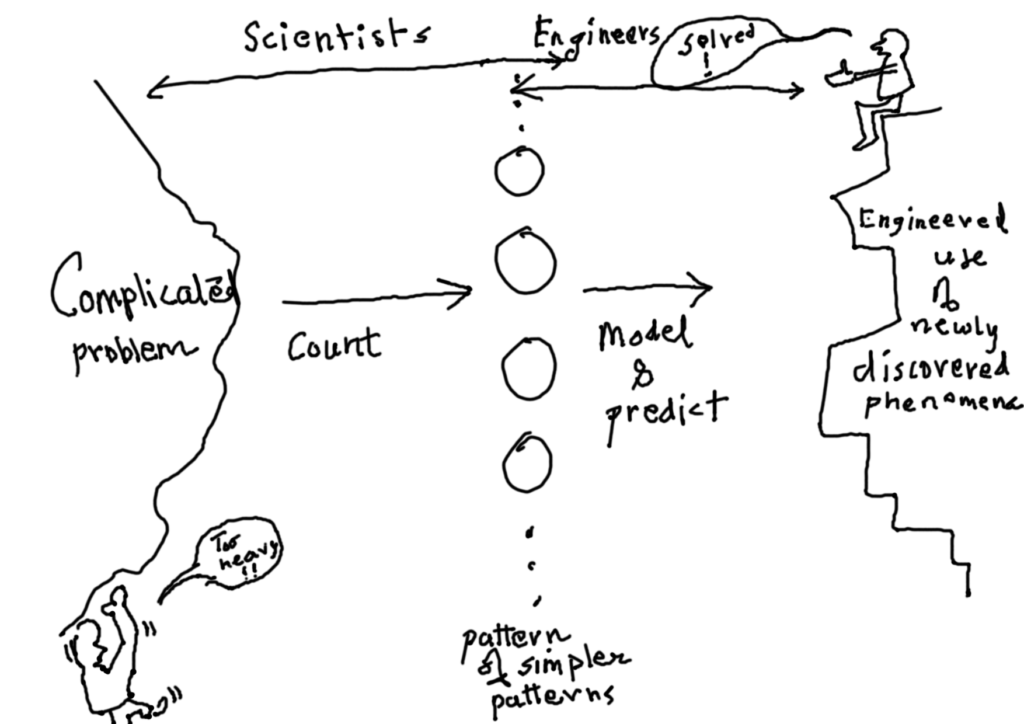
So what’s math got to do with all this pattern business? Well, math is basically counting. Why do we need to count and what is that? One way to put it is to account for something big and complicated by repeating something small and simple in so many counts. For example, you wish to move a table through a door. One way is to haul the heavy table and through trial and error see if it can get past the door with a few iterations. Another wiser way is to count the door dimensions as multiples of your palm width, and then do the same for the table. After you note these down, you can then simplify these further, and figure out which orientation of the table with respect to the door can achieve what you set out for. So the abstractification of the problem helps our mind to process, imagine, draw and basically manipulate known information (dimensions of the door and table) to illuminate the unknown (how to get one across the other). That is the essence of basic math.

An example could be language. If someone’s speaking to you in sounds, how can you convert that into something you understand? So, typically you would record it – meaning count the intensity/volume of the person over a span of time. Then you would see if certain sound bytes correspond to the finger pointing of the person to certain fixed objects. This is searching for patterns. Then when you know say ‘debbidabbypoo’ corresponds to ‘run’ and ‘haletkaletpichkao’ corresponds to ‘You’ then you create a model sentence to test your interpretation on to the other person, something like ‘haletkaletpichkao debbidabbypoo’. This model will then be put on test and if the person runs away, you have a working model (and a lost sample)! But this is risky, you would like to learn first how to tell the person to come back before you ask it to run away. Now you see you are manipulating the situation to your benefit, also called taming the model. Similar things happen in all sorts of problems, and math is this tool that can help quantify, patternize, model, and simulate based on counting numbers and abstracting.
Previous version, as described in a previous post here, underwent many changes. Primarily it suffered from the slow processing time of the Arduino Mega it was based on. The challenge was – how to control the stepper motor while also reading pressure sensors and computing the tidal volume and breathing pressure, all at almost the same time. This was kind of solved by upgrading to ESP32 microcontroller.

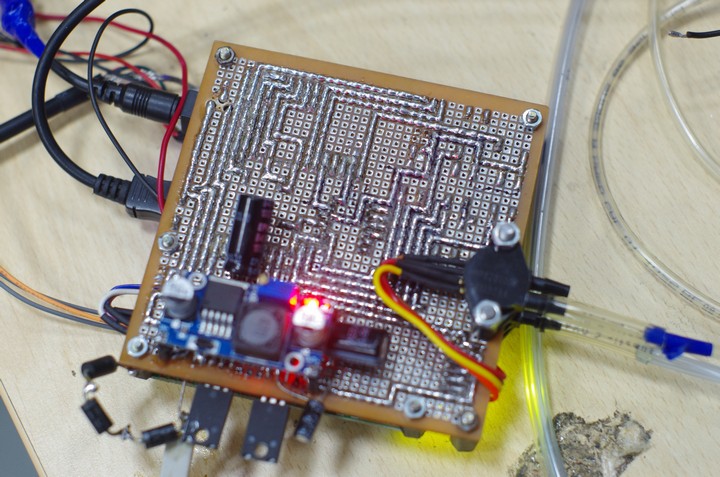
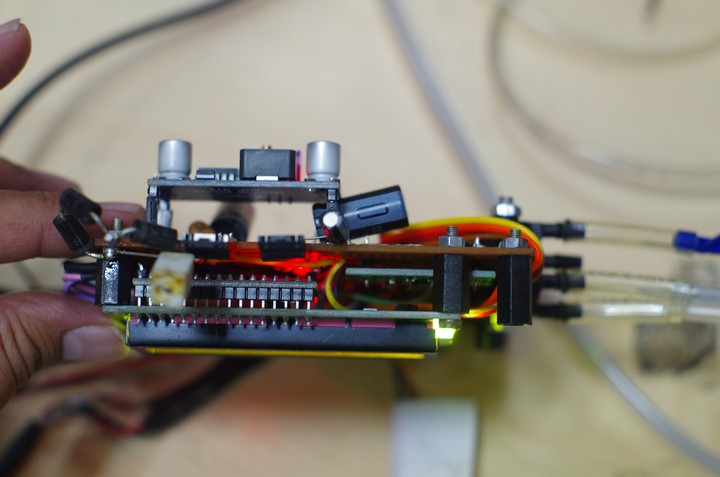
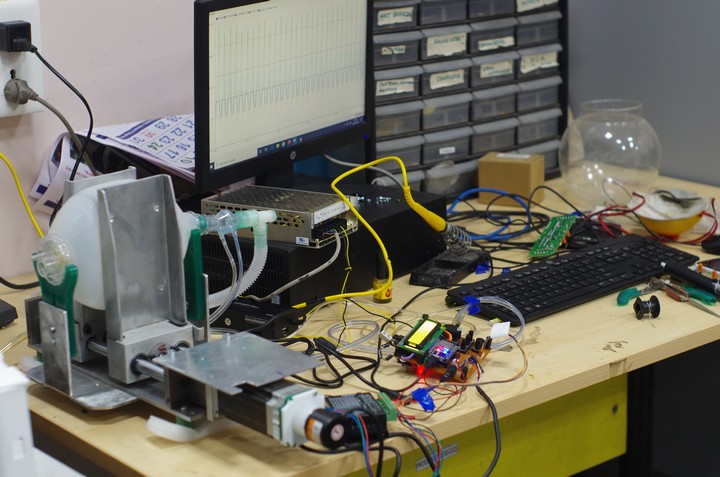
However this didnt solve it. Finally, the stepper motor was chucked for a DC motor. This worked great.
So i have to teach a basic calculus course at the SSLA this coming semester. Tense? Sure! Why? I’v never done this before (… biting my nails). If you are a potential student of mine seeing this post, i would like to assure you that I am a bit handy with calculus. But yes, the thing to worry about is that i am nowhere near as practiced or proficient as a good teacher should be! And also that teaching is an art, not everyone’s cup of tea. But i’m learning that art, so please bear with me. The way i do it, or like to do it is to experiment and co-learning.
Worries apart, i wonder what should be the role of a teacher in such a class? Or put in another way, what transformation should the participants have after going through this class? Or even more basic, what should basic calculus mean to anyone? I am not clear about the former 2 questions, but for the latter i can imagine the following possibilities:
Personally, i have had a lot of content in #4s, and sadly i can vouch for their uselessness. But i have also had the opportunity of being around point #3 during my projects work, and have learnt to appreciate it as a great tool. But with this 3 month elective course (thanks to Sumithra Surendralal – my friend and a wonderful science and math teacher from the SSLA who suggested i try it out this semester) i will upgrade a bit to region #2, i hope. And with the students, I hope they carry away at the end of the course some of the joys (#2) and utilities(#3) of basic calculus. And i hope that i would help my kids steer clear of #5.